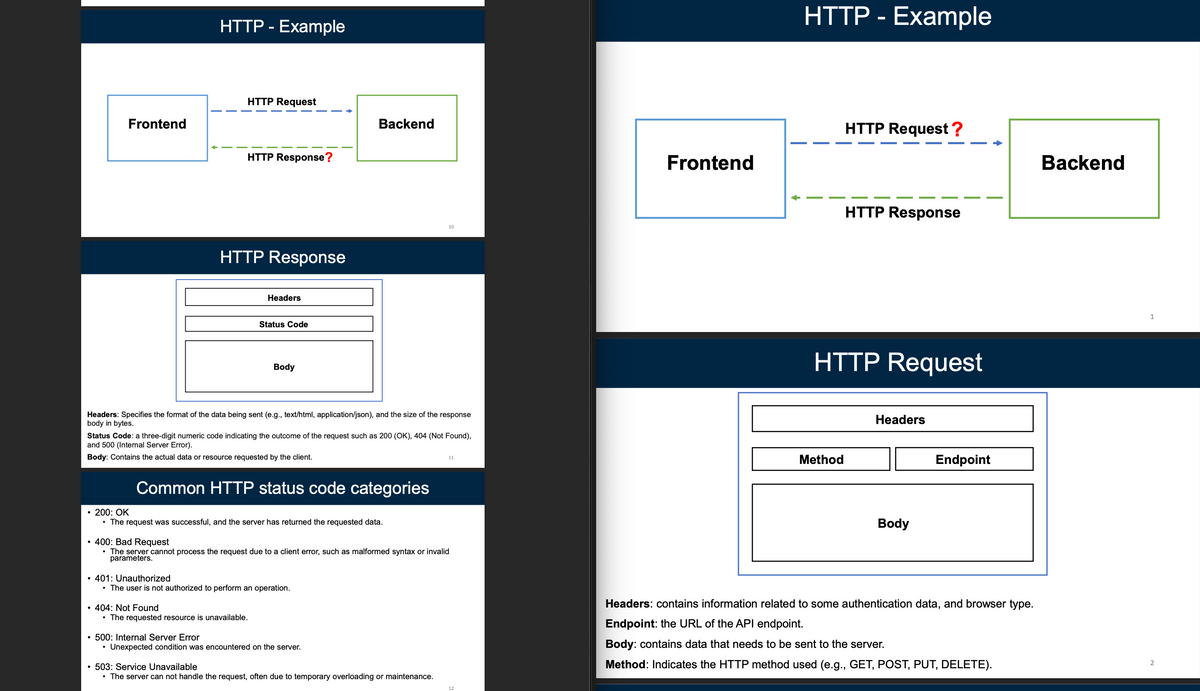Construct a diagram to depict the structure of an HTTP response. Elucidate every component of the response, including status line (version, status code, and reason phrase), headers, and body. Addition- ally, furnish a compendium of standard HTTP status codes, categorizing them and providing at least three examples for each category:
Construct a diagram to depict the structure of an HTTP response. Elucidate every component of the response, including status line (version, status code, and reason phrase), headers, and body. Addition- ally, furnish a compendium of standard HTTP status codes, categorizing them and providing at least three examples for each category:
New Perspectives on HTML5, CSS3, and JavaScript
6th Edition
ISBN:9781305503922
Author:Patrick M. Carey
Publisher:Patrick M. Carey
Chapter13: Programming For Web Forms: Creatings Forms For Orders And Pa
Section13.2: Visual Overview: Passing Data Between Forms
Problem 3QC
Related questions
Question
-
Construct a diagram to depict the structure of an HTTP response. Elucidate every component of the response, including status line (version, status code, and reason phrase), headers, and body. Addition- ally, furnish a compendium of standard HTTP status codes, categorizing them and providing at least three examples for each category:
• 1xx (Informational): Briefly describe and provide three examples.
4xx (Client Error): Discuss the significance and provide three examples.
• 2xx (Success): Elaborate on the category and list three examples.
• 3xx (Redirection): Explain the purpose of redirection codes and offer three instances.
• 5xx (Server Error): Detail this category and list three examples.

Transcribed Image Text:Construct a diagram to depict the structure of an HTTP response. Elucidate every component of the
response, including status line (version, status code, and reason phrase), headers, and body. Addition-
ally, furnish a compendium of standard HTTP status codes, categorizing them and providing at least
three examples for each category:
• 1xx (Informational): Briefly describe and provide three examples.
• 2xx (Success): Elaborate on the category and list three examples.
• 3xx (Redirection): Explain the purpose of redirection codes and offer three instances.
• 4xx (Client Error): Discuss the significance and provide three examples.
• 5xx (Server Error): Detail this category and list three examples.

Transcribed Image Text:Frontend
HTTP - Example
HTTP Request
HTTP Response?
HTTP Response
Headers
Status Code
Body
Backend
10
Headers: Specifies the format of the data being sent (e.g., text/html, application/json), and the size of the response
body in bytes.
Status Code: a three-digit numeric code indicating the outcome of the request such as 200 (OK), 404 (Not Found),
and 500 (Internal Server Error).
Body: Contains the actual data or resource requested by the client.
Common HTTP status code categories
11
• 200: OK
• The request was successful, and the server has returned the requested data.
• 400: Bad Request
• The server cannot process the request due to a client error, such as malformed syntax or invalid
parameters.
• 401: Unauthorized
• The user is not authorized to perform an operation.
• 404: Not Found
• The requested resource is unavailable.
• 500: Internal Server Error
• Unexpected condition was encountered on the server.
• 503: Service Unavailable
• The server can not handle the request, often due to temporary overloading or maintenance.
12
Frontend
HTTP - Example
HTTP Request?
HTTP Response
HTTP Request
Method
Headers
Body
Endpoint
Headers: contains information related to some authentication data, and browser type.
Endpoint: the URL of the API endpoint.
Body: contains data that needs to be sent to the server.
Method: Indicates the HTTP method used (e.g., GET, POST, PUT, DELETE).
Backend
1
2
Expert Solution
This question has been solved!
Explore an expertly crafted, step-by-step solution for a thorough understanding of key concepts.
This is a popular solution!
Trending now
This is a popular solution!
Step by step
Solved in 3 steps with 1 images

Knowledge Booster
Learn more about
Need a deep-dive on the concept behind this application? Look no further. Learn more about this topic, computer-science and related others by exploring similar questions and additional content below.Recommended textbooks for you

New Perspectives on HTML5, CSS3, and JavaScript
Computer Science
ISBN:
9781305503922
Author:
Patrick M. Carey
Publisher:
Cengage Learning

New Perspectives on HTML5, CSS3, and JavaScript
Computer Science
ISBN:
9781305503922
Author:
Patrick M. Carey
Publisher:
Cengage Learning